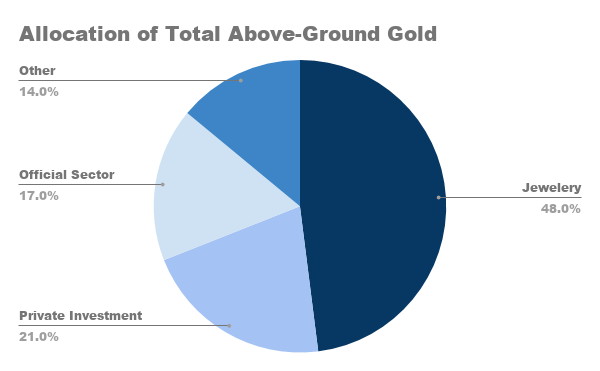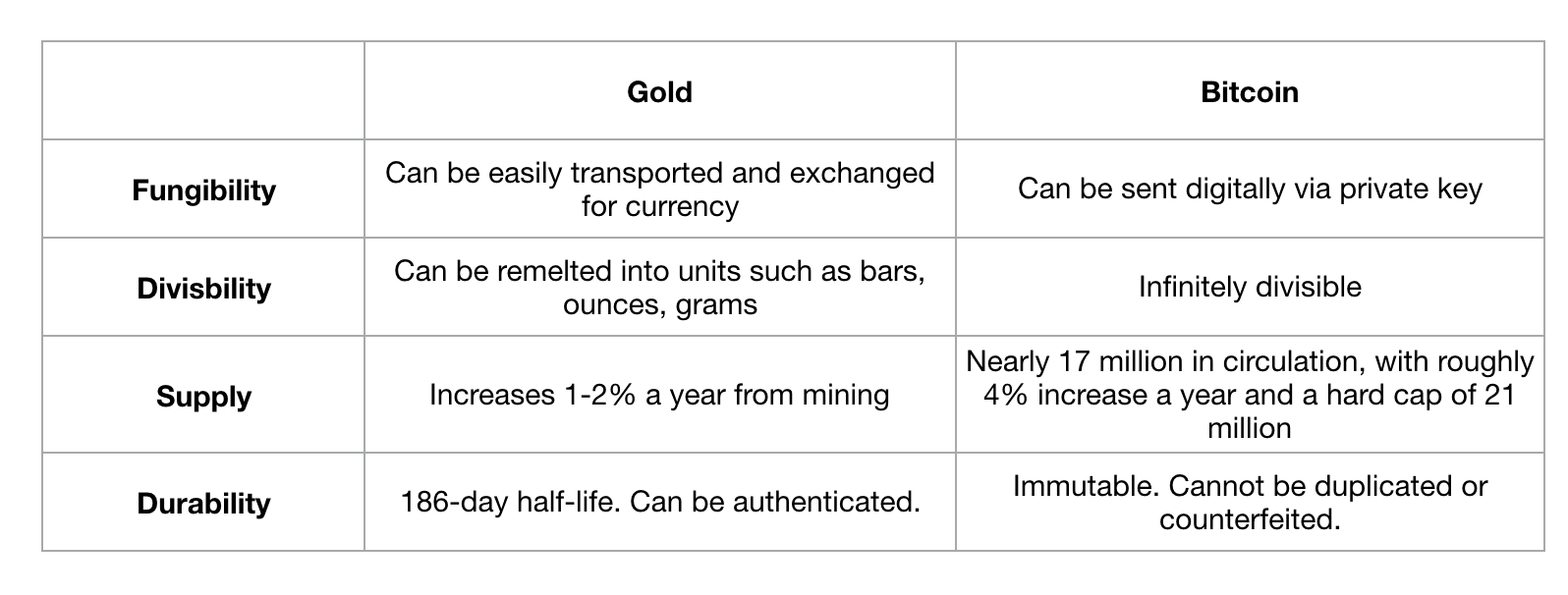Over the past year, Bitcoin’s been on a wild ride from a low of $1,183 to a peak of $19,401.
With Bitcoin’s skyrocketing prices, detractors from J.P. Morgan chief Jamie Dimon (“[Bitcoin] is a fraud”) to Berkshire Hathaway CEO Warren Buffett (“I can say almost with certainty that [cryptocurrencies] will come to a bad ending”) have been quick to decry the digital currency as a bubble.
Predicting a crypto bubble has become the latest trend as Bitcoin and other currencies have risen meteorically. In spite of this, Bitcoin has shown that it is still a new asset with room to grow.
Bitcoin’s current market cap of $134 billion, is massive compared to most companies, and even some countries. But this pales in significance compared to traditional assets like gold. If Bitcoin becomes a widely accepted store of value, it may one day replace some of the functions of gold in the market.
Today, there is an estimated 190,040 tonnes of gold above ground in the world, with 54,000 known reserves below ground that can be mined. At today’s rate of $1,335 per ounce, that means there’s around $11.5 trillion worth of gold in the world that we know about.
Imagine that Bitcoin replaces 25% of today’s gold market. Bitcoin would leapfrog another 17x above today’s current prices.
Here’s some (very rough) back-of-the-paper-wallet math:
25% of $11.5 trillion gold reserves = $2.86 trillion$1.975 trillion market cap of bitcoin / 21 million bitcoin= 136,190 price per bitcoin
While this scenario may seem extremely far-fetched, it’s not completely out of the realm of reality. In this article, we’ll look at some of the key characteristics that Bitcoin shares with gold that make it useful as a store of value and speculate around how Bitcoin might eat into the dominance of gold.
What is a Store of Value?
Skeptics like to point out that Bitcoin isn’t that useful as a currency. It can have high fees, long transaction times, and comes with numerous security risks. It’s still much easier to pay for goods and services with a credit card than sending bitcoin to someone’s public address.
Yet all these things actually make Bitcoin similar to something people have valued for thousands of years: gold.
Gold has certain properties that make it useful. It conducts electricity well, and it looks pretty. But if you compare gold to more common metals such as copper or nickel, it’s actually a lot less useful for making things — it bends too easily.
The main utility of gold is that it functions as a store of value. Because gold is extremely scarce and expensive to produce it tends to retain value over time. If you buy gold today, you’ll likely be able to exchange it for a similar amount in the future.
To understand how gold functions as a store of value and how Bitcoin might replace it, we have to dig deeper into the history of gold.
A Brief Primer on Gold
Gold has been valued and used as a store of value for millennia. The first known use of gold as currency began several thousand years ago in Asia.
Even with the widespread adoption of paper currency in the form of bank notes in the 19th century, the gold standard remained the most popular financial system in the world. Nations would set a fixed price that they would trade gold for paper money. For centuries, gold was an acceptable form of currency. That’s a big part of why gold is still valuable today — we believe that gold is valuable, and this belief has been culturally ingrained.
Gold has a number of properties that make it useful as a store of value. For starters, it lasts a really long time. The half-life of Carbon-14 is 5,730 years. The half-life of the main gold isotope, meanwhile, is stable over any known time period. It is largely inert, which means it doesn’t corrode, tarnish, or decay over time.
It’s easy to split up into smaller parts and transport. You can remelt a gold ingot into smaller gold coins, or even smaller pieces of jewelry.
Gold is also portable: an ounce of gold is worth $1,335 and weighs the same as a slice of bread. It’s estimated that the 190,040 tonnes of gold above ground would fit into a cube with 67 foot sides.
Today, we use gold for many different things. Jewelry is the most common use-case representing roughly 48% of all above-ground gold. 21% is used for private investment, whether in the physical form of gold bullion or in financial instruments like exchange-traded funds. Another 17% is used by the official sector by central banks as a reserve currency. The other 14% is used for other purposes, from industrial applications like electronics to dentistry.

While the gold standard has largely been abandoned, gold remains a useful hedge against currency instability.
That’s because gold is inherently scarce, with a limited supply. On average, 1,500–3,000 tonnes of gold is mined each year, adding a mere 1–2% annual increase to the supply of gold. It’s also highly liquid and can be exchanged for money anywhere in the world.
Central banks buy gold to avoid currency risks and hedge against inflation. Gold is held in reserve and can be liquidated quickly in times of crises. In 2016, Russia’s central bank purchased 201 tonnes of gold in response to a weakening rouble and international sanctions, making it the largest acquirer of gold.
Today, gold continues to retain its significance because it operates as a store of value that’s removed from the financial system.
The Bull Case for Bitcoin: Why Bitcoin may replace Gold
On the surface, Bitcoin and gold couldn’t be more different. Bitcoin is a digital, peer-to-peer currency created in 2008, and distributed across nodes around the world. Gold is a natural element that is mined from the ground, and which has been used as a store of value for millennia.
Despite these differences, Bitcoin and gold both share characteristics that make them useful as a store of value:

Just like the supply of gold is constrained to the amount that can be mined, the supply of Bitcoin is written into the code and maxes out at 21 million coins. While gold is relatively portable, can be verified, and divided into smaller units, Bitcoin is cryptographically secured, controlled via private key, and can be divided infinitely. That gives it distinct advantages over gold as a store of value.
While gold is useful as a store of value because it’s valuable relative to physical size, this still adds up when you’re operating at scale. For example, when the German central bank wanted to bring home 374 metric tons of gold back to Frankfurt, the gold had to be assessed for purity, be remolded from bullion into bars, then secured and transported. The whole operation cost $ 9 million. There’s a clear argument that a digital currency like Bitcoin would be much better suited to maintain reserves than gold bars.
Central banks are already beginning to look at the benefits of digital currencies. The Swedish central bank is investigating the possibility of launching a digital supplement to cash, called the e-krona. Singapore is experimenting with use-cases for cryptocurrency from cross-border payments to creating a digital Singapore dollar.
Similar to gold, Bitcoin sees high usage as a store of value in countries with currency controls or instability. In Argentina, for example, people use Bitcoin to circumvent government currency controls mean, saving nearly 40% on foreign currency exchanges. In Venezuela, Bitcoin usage has become widespread to buy everything from food to movie tickets in the face of 2,616% inflation. The Venezuelan government even launched its own contentious cryptocurrency, called the Petro, in an effort to circumvent international sanctions.
Like gold, Bitcoin provides a store of value that’s separated from the official financial system. Unlike gold, Bitcoin is far easier to hold onto and exchange. If 25% of the gold that’s used as a store of value in jewelry, private investment, and the official sector moves to Bitcoin, we may see Bitcoin at $136,190.
The New Gold Standard
Bitcoin rose from the 2008 financial crash, promising a digital currency free from central bank intervention. This is something that we’ve always needed — just look at gold. Gold is useful because it provides a store of value outside of currency and stock markets. Bitcoin, if it’s able to address key technical and scalability challenges, has the potential to do the same.
What’s important to remember is that despite the boom-and-bust hype cycle, we’re still in the early innings.
The above references an opinion and is for informational purposes only. It is not intended as and does not constitute investment advice, and is not an offer to buy or sell or a solicitation of an offer to buy or sell any cryptocurrency, security, product, service or investment. Seek a duly licensed professional for investment advice. The information provided here or in any communication containing a link to this site is not intended for distribution to, or use by, any person or entity in any jurisdiction or country where such distribution or use would be contrary to law or regulation or which would subject SFOX, Inc. or its affiliates to any registration requirement within such jurisdiction or country. Neither the information, nor any opinion contained in this site constitutes a solicitation or offer by SFOX, Inc. or its affiliates to buy or sell any cryptocurrencies, securities, futures, options or other financial instruments or provide any investment advice or service.



